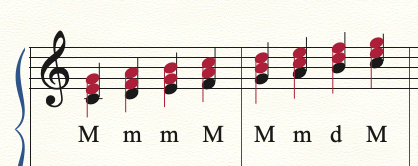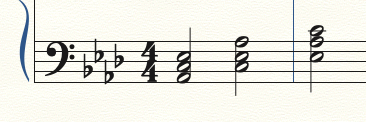Unit 3 Overview: Music Fundamentals III (Triads and Seventh Chords)
7 min read•june 18, 2024
Sumi Vora
AP Music Theory 🎶
72 resourcesSee Units
3.1 Triad and Chord Qualities (M, m, d, A)
Triads are chords that consist of 3 distinct pitches, a combination of two thirds (intervals) stacked on one another.
There are four types of triads: major (M), minor (m), diminished (d), and augmented (A). A major triad consists of a root note, a major third interval above the root, and a perfect fifth interval above the root. A minor triad consists of a root note, a minor third interval above the root, and a perfect fifth interval above the root. A diminished triad consists of a root note, a minor third interval above the root, and a diminished fifth interval above the root. An augmented triad consists of a root note, a major third interval above the root, and an augmented fifth interval above the root.
Triads are typically played with the root note in the bass, or lowest part, and the other two notes stacked on top. However, they can also be played in inversions, where the root note is not in the bass. In a first inversion triad, the middle note is played in the bass, and in a second inversion triad, the top note is played in the bass. Inverting a triad can change the overall sound and feel of the chord, and we will usually invert chords so we can have good voice leading in our music.

From right to left: C Major, C minor, C diminished, C augmented
3.2 Diatonic Chords and Roman Numerals
Diatonic chords are chords that are built using only the notes of a specific scale. For example, if we are working in the key of C major, the diatonic chords would be built using the notes C, D, E, F, G, A, and B. These chords can be major, minor, diminished, or augmented, and they will follow a specific pattern of intervals based on the scale.
Major Diatonic Triads
In Major key, the diatonic chords built on each scale degree are:

We can refer to each triad by the name of its root note. For example, in C Major, the C Major triad is called the tonic triad.
Roman numerals are used in music theory to represent chords, and they are often used in conjunction with diatonic chords. Roman numerals are used to identify these chords and indicate their root, or starting note. Remember that if the chord is inverted, then the root still stays the same. The root is the starting note when the chord is not inverted (i.e. in root position). So, in C Major, a GBD is a V chord, but a BDG is also a V chord.
Minor Diatonic Triads
Minor scales take on a different pattern. In a minor key, the diatonic chords are represented in a similar way, but with the exception that the chords built on the third, fifth, and sixth scale degrees are typically major chords and the chords built in the first and fourth scale degrees are usually minor. The chord built on the second scale degree is usually diminished.
The seventh scale degree can be a little tricky. If we use the harmonic minor and sharp the seventh scale degree, then we have a diminished seven chord. However, if we use natural minor and we don’t sharp the seven, then we just get a major chord! Composers will use both the major seven chord and the diminished seven chord in different contexts in music, but the major seven chord is usually more common.
And, for the V chord, we actually make it into a major chord by altering the third of the chord. In a minor key, the V chord is naturally minor, but to keep it always as a major chord, we raise the third by a half-step.
Here are the diatonic triads in minor key:

3.3: Chord Inversions and Figures
All the notes of a chord can be rearranged so that the order from bottom to top may be different. The most important note is the bass note. When the root of the chord appears in the bass, we consider this to be in root position. If a different chord member appears in the bass, we have was is called a chord inversion.
When the third of the chord is in the bass, the chord is considered to be in 1st inversion. When the fifth is in the bass, the chord is considered to be in 2nd inversion.

Figured Bass
During the Common Practice Period (CPP), a.k.a. The Baroque era, chord inversions were labeled using Arabic numerals (the numbers you and I normally know and use: 1, 2, 3, etc.) to denote the intervals seen above the bass note. This system was used extensively by Bach, Handel, and Vivaldi. We call this figured bass.
The system of figured bass consists of a bass line and a series of numbers written below the bass line. The numbers indicate the intervals above the bass note that should be played or sung, and they are called "figures." When we are looking at a composition through a harmonic lens, these figures (usually written in Arabic numerals) are used to signify the corresponding inversions to each chord.
They indicate the exact interval between the bottom note and the top note when an inversion is in a closed position. Closed position means that the notes are as close as possible, and the chord is some cycling of the 1-3-5 order. For example, root position will be in the order 1-3-5, first inversion will be in the order 3-5-1, and second inversion will be in the order 5-1-3.
In root position, the figures of a triad are 5/3. In first inversion, they are 6/3. And, finally, in second inveresion, they are 6/4. However, when we write figures, we usually don't write anything for root position triads, we only write a 6 for first inversion triads, and we write a 6/4 for second inversion triads.
3.4: Seventh Chords
Seventh chords are chords that consist of four notes, with the fourth note being a seventh interval above the root note. Like triads, seventh chords are an important part of tonal harmony and are found in many different styles of music. There are several types of seventh chords, including major seventh chords, minor seventh chords, dominant seventh chords, diminished seventh chords, and half-diminished seventh chords.
Seventh Chord Qualities
A major seventh chord consists of a root note, a major third interval above the root, a perfect fifth interval above the root, and a major seventh interval above the root. It has a bright, happy sound and is often used to create a sense of resolution or closure in a piece of music. We might also write major seventh chords as MM chords, since there is a major triad followed by a major third.
A minor seventh chord (mm) consists of a root note, a minor third interval above the root, a perfect fifth interval above the root, and a minor seventh interval above the root. It has a more mellow, contemplative sound and is often used to create a sense of tension or dissonance.
A dominant seventh chord (Mm) consists of a root note, a major third interval above the root, a perfect fifth interval above the root, and a minor seventh interval above the root. It is one of the most common types of seventh chords and is used extensively in blues, jazz, and rock music. It has a strong, bluesy sound and is often used to create a sense of tension or instability that needs to be resolved.
A diminished seventh chord consists of a root note, a minor third interval above the root, a diminished fifth interval above the root, and a diminished seventh interval above the root. It has a very tense, dissonant sound and is used to create a sense of instability or unease. The half-diminished seventh chord is similar to a diminished seventh chord, but with a minor seventh interval instead of a diminished seventh interval. Sometimes, we will denote seventh chords with a little circle and a line through it. It has a very tense, dissonant sound and is often used to create a sense of instability or unease in a piece of music.

Diatonic Seventh Chords
In Major, the chords built on the first, fourth, and fifth scale degrees are major chords, and the chords built on the second, third, and sixth scale degrees are minor chords. The chord built on the seventh scale degree is a diminished chord.
For example, in the key of C major, the diatonic seventh chords are C major seventh (I), D minor seventh (ii), E minor seventh (iii), F major seventh (IV), G dominant seventh (V), A minor seventh (vi), and B half-diminished seventh (viiø).
In minor, we raise the leading tone for the V and vii chords. Thus, the chords built on the first and fourth scale degrees are minor chords, and the chords built on the third, and seventh scale degrees are major chords. The chord built on the third scale degree is a diminished chord.
For example, in the key of A minor, the diatonic seventh chords are A minor seventh (i), B half-diminished seventh (iiø), C major seventh (III), D minor seventh (iv), E major seventh (V), F major seventh (VI), and G major seventh (vii°).
3.5: Seventh Chord Inversions and Figures
For seventh chords, we construct figures based on inversions in the same way as we do for triads. The figures for root position seventh chords are just 7, the figures for first inversion seventh chords are 6/5, the figures for second inversion seventh chords are 4/3, and the figures for third inversion seventh chords are 4/2.
Browse Study Guides By Unit
🎵Unit 1 – Music Fundamentals I (Pitch, Major Scales and Key Signatures, Rhythm, Meter, and Expressive Elements)
🎶Unit 2 – Music Fundamentals II (Minor Scales and Key Signatures, Melody, Timbre, and Texture)
🎻Unit 3 – Music Fundamentals III (Triads and Seventh Chords)
🎹Unit 4 – Harmony and Voice Leading I (Chord Function, Cadence, and Phrase)
🎸Unit 5: Harmony and Voice Leading II: Chord Progressions and Predominant Function
🎺Unit 6 – Harmony and Voice Leading III (Embellishments, Motives, and Melodic Devices)
🎤Unit 7 – Harmony and Voice Leading IV (Secondary Function)
🎷Unit 8 – Modes & Form
🧐Exam Skills
📚Study Tools

Fiveable
Resources
© 2025 Fiveable Inc. All rights reserved.